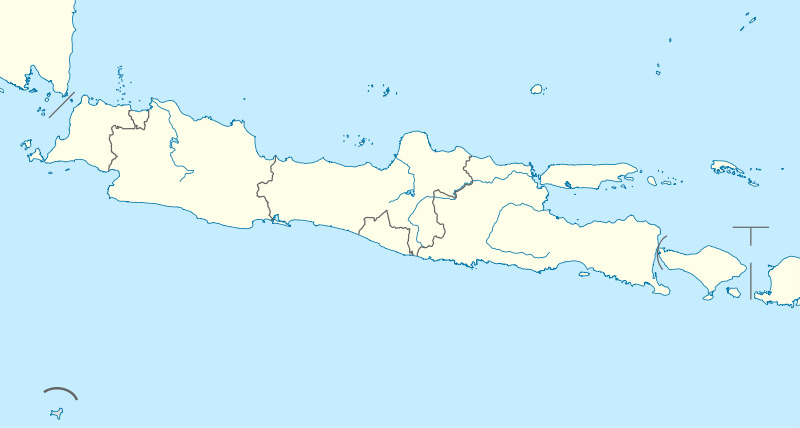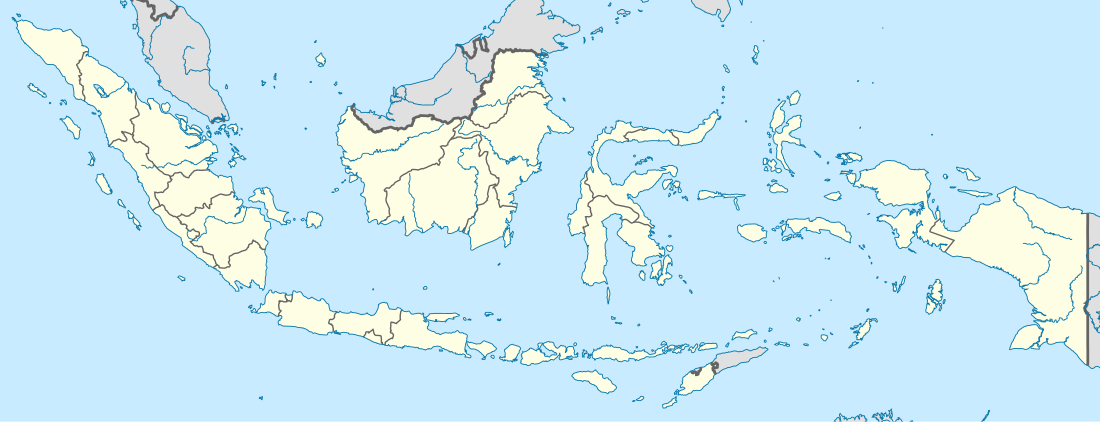Semarang
Semarang is the capital and largest city of Central Java province in Indonesia. A major port during the Dutch colonial era, and still an important regional centre and port today. The city has been named as the cleanest tourist destination in Southeast Asia by the ASEAN Clean Tourist City Standard (ACTCS) for 2020–2022.[2]
Semarang | |
|---|---|
| City of Semarang Kota Semarang | |
| Other transcription(s) | |
| • Javanese | ꦏꦸꦛꦯꦼꦩꦫꦁ |
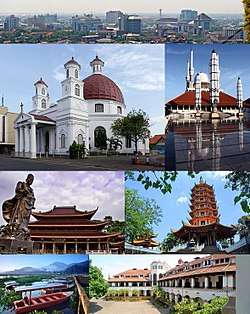 From top, left to right: Semarang city skyline, Semarang's Blenduk Church is the oldest Church in Central Java, The Great Mosque of Central Java, Gedung Batu Temple (the oldest Chinese temple), Pagoda Avalokitesvara, Rawa Pening (Pening swamp) water tourism, and iconic building of Lawang Sewu. | |
 Seal | |
| Nickname(s): Venetië van Java, Lumpia City | |
| Motto(s): Semarang Kota ATLAS | |
 Location within Central Java | |
| Coordinates: 6°58′S 110°25′E | |
| Country | |
| Province | |
| Government | |
| • Mayor | Hendrar Prihadi |
| • Vice Mayor | Hevearita Gunaryanti Rahayu |
| Area | |
| • City | 373.78 km2 (144.32 sq mi) |
| • Metro | 1,643.4 km2 (634.5 sq mi) |
| Elevation | 4 m (13 ft) |
| Population (2010) | |
| • City | 1,555,984 |
| • Density | 4,200/km2 (11,000/sq mi) |
| • Metro | 3,183,516 |
| • Metro density | 1,900/km2 (5,000/sq mi) |
| Demonym(s) | Semarangan |
| Demographics | |
| • Ethnic groups | Javanese Chinese Indian Arab Sundanese Batak Madura |
| • Religion[1] | Islam 86.78% Protestantism 6.91% Catholicism 4.97% Buddhism 0.64% Hinduism 0.10% Confucianism 0.07% Others 0.01% |
| Time zone | UTC+7 (IWST) |
| Area code | (+62) 24 |
| Vehicle registration | H |
| Website | semarangkota |
It has an area of 373.78 square kilometres (144.32 sq mi) and is located at 6°58′S 110°25′E. The population of the city is approximately 1.8 million people, making it Indonesia's seventh most populous city[3] after Jakarta, Surabaya, Bandung, Bekasi, Medan, and Tangerang. The built-up urban area had 3,183,516 inhabitants at the 2010 census spread on 2 cities and 26 districts.[4] The Semarang metropolitan area (a.k.a. Kedungsapur) has a population of close to 6 million (see Greater Semarang section). The population of the city is predominantly Javanese with significant Chinese presence.
History
![]()
![]()
![]()
![]()
![]()
![]()
![]()
The history of Semarang goes back to the 9th century, when it was known as Bergota. At the end of the 15th century, an Arab named Kyai Pandan Arang founded a village and an Islamic school in this fishing village. On 2 May 1547, Sultan Hadiwijaya of Pajang Kyai declared Pandan Arang the first bupati (mayor) of Semarang, thus creating Semarang administratively and politically.
In 1678, Sunan Amangkurat II promised to give control of Semarang to the Dutch East India Company (VOC) as a part of a debt payment. In 1682, the Semarang state was founded by the Dutch colonial power. On 5 October 1705 after years of occupations, Semarang officially became a VOC city when Susuhunan Pakubuwono I made a deal to give extensive trade rights to the VOC in exchange of wiping out Mataram's debt. The VOC, and later, the Dutch East Indies government, established tobacco plantations in the region and built roads and railroads, making Semarang an important colonial trading centre.
The historic presence of a large Indo (Eurasian) community in the area of Semarang is also reflected by the fact a creole mix language called Javindo existed there.[5]
Classical Indische Town (1678–1870)

Semarang was handed by the Sultan of Mataram to the Dutch East Indies in 1678. The city was pictured as a small settlement with a pious Muslim area called Kauman, a Chinese quarter, and a Dutch fortress. The fortress has a pentagonal form with only one gate in the south and five monitoring towers to protect the Dutch settlement from rebellion actions, segregating the spaces between Dutch settlement and other areas.[6] In fact, the city of Semarang was only referred to the Dutch quarter while the other ethnic settlement were considered as villages outside the city boundary. The city, known as de Europeesche Buurt, was built in classical European style with church located in the centre, wide boulevards, streets and villas.[7] According to Purwanto (2005),[8] the urban and architectural form of this settlement is very similar to the design principles applied in many Dutch cities, which begun to concern on the urban beautification.
Due to the long and costly Java War, there was not much funding from the Dutch East Indies government, which affected Semarang's development. The majority of land was used for rice fields and the only small improvement was the development of a surrounding fortress. Although less developed, Semarang has a fairly arranged city system, in which urban activities were concentrated along the river and the settlement was linked to a market where different ethnic groups met to trade. The existence of the market, in the later years, become a primary element and a generator of urban economic growth.[9]
An important influence on urban growth was the Great Mail Road project in the 1847, which connected all the cities in the northern coast of Central and East Java and positioned Semarang as the trade centre of agricultural production.[10] The project was soon followed by the development of the Netherlands Indies railway and the connecting roads into the inner city of Semarang at the end of the 19th century.[9] Colombijn (2002)[10] marked the development as the shift of urban functions, from the former river orientation to all services facing the roads.
The modern city (1870–1922)
.svg.png)
Improved communication, the result of the Mail and Railway projects, brought an economic boom to the city in the 1870s. There were hospitals, churches, hotels, and large houses built along new main roads; Bojongscheweg, Pontjolscheweg, and Mataram street, densified population in the ethnic settlements and created the urban kampong (village).[7]
Urban growth densified the urban kampong, reaching 1,000 inhabitants per hectare and degrading the quality of living conditions.[11] In the early 20th century, mortality rate were high due to the overcrowding and lack of hygiene that triggered cholera and tuberculosis outbreaks.[12] Cobban (1993)[11] noted the ethical movement of kampongverbetering led by Henry Tillema in 1913 and the concern of the Advisor for Decentralisation for kampong improvement through the betterment of public toilets, drainage, and the planning of public housing.
In 1917, a healthy housing project was implemented in the Southern part of Semarang called Candi Baru. Thomas Karsten, the advisor for city planning, transformed the concept of ethnic segregation that divided previous urban settlements into a new housing district plan based on economic classes. Although practically the three ethnic groups were also divided into three economic classes where the Dutch and rich Chinese occupied the largest lots in the housing district,[7] Karsten had effectively emerged the developed district by integrating the road network, introducing newly improved public washing and bathing, squares and sporting facilities that could be used communally.[13] Following the Candi Baru, there were three other housing plans between 1916–1919 to accommodate a 55% population increase in Semarang; 45,000 Javanese, 8500 Chinese and 7000 Europeans. Karsten marked a new approach to town planning with emphasis on the aesthetic, practical and social requirements, articulated not in terms of race but economic zones.[13]
Driven by economic growth and spatial city planning, the city had doubled in size and expanded to the south by the 1920s, creating a nucleus of a metropolis where multi-ethnic groups lived and traded in the city. The villages in the suburbs such as Jomblang and Jatingaleh steadily became the satellite towns of Semarang, more populated with a bigger market area. Before the invasion of Japan in 1942, Semarang had already become the capital of Central Java Province, as the result of trade and industrial success and spatial planning.[7]
_in_Semarang_TMnr_10032316.jpg)
 A Chinese house in Semarang at the turn of the 20th century.
A Chinese house in Semarang at the turn of the 20th century.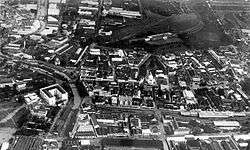 Aerial picture of Old Semarang area in the 1920s.
Aerial picture of Old Semarang area in the 1920s. Old 0-6-0 locomotive next to the Lawang Sewu building.
Old 0-6-0 locomotive next to the Lawang Sewu building.
Japanese occupation and early independence
The Japanese military occupied the city, along with the rest of Java, in 1942, during the Pacific War of World War II. During that time, Semarang was headed by a military governor called a Shiko, and two vice governors known as Fuku Shiko. One of the vice governors was appointed from Japan, and the other was chosen from the local population.
After Indonesian independence in 1945, Semarang became the capital of Central Java province in 18 August 1945,[14] headed by Mr. Moch.Ichsan.[15] It also became the site of a battle between Indonesian and Japanese soldiers in October 1945.[16]
Administration
Semarang city administration is headed by mayor, with a legislative assembly. Both mayor and members of legislative assembly are elected by direct vote. Semarang City Government had implemented the smart city concept since 2013.[17][18]
Juridically, Semarang City is a municipality (second level area) consisting of 16 districts (kecamatan), which again divided into 177 urban villages (kelurahan). The widest sub-district area in Semarang City is Mijen sub-district which has an area of 57.55 square kilometers. The smallest sub-district area is South Semarang District, which is only 5.93 square kilometers. The city of Semarang is divided into five urban areas, including: Central Semarang, East Semarang, West Semarang, South Semarang, and North Semarang. Following are the districts and urban villages of Semarang,
| Sub-district | Administrative villages |
|---|---|
| Banyumanik | Pudakpayung, Gedawang, Jabungan, Padangsari, Banyumanik, Srondol Wetan, Pedalangan, Banyumanik, Semarang, Sumurboto, Banyumanik, Semarang, Srondol Kulon, Banyumanik, Semarang, Tinjomoyo, Ngesrep |
| Candisari | Candi, Jatingaleh, Jomblang, Kaliwiru, Karanganyargunung, Tegalsari, Wonotingal |
| Gajahmungkur | Bendanduwur, Bendanngisor, Bendungan, Gajahmungkur, Karangrejo, Lempongsari, Petompon, Sampangan |
| Gayamsari | Gayamsari, Kaligawe, Pandean Lamper, Sambirejo, Sawah Besar, Siwalan, Tambakrejo |
| Genuk | Bangetayu Kulon, Bangetayu Wetan, Banjardowo, Gebangsari, Genuksari, Karangroto, Kudu, Muktiharjo Lor, Penggaron Lor, Sembungharjo, Terboyo Kulon, Terboyo Wetan, Trimulyo |
| Gunungpati | Cepoko, Gunungpati, Jatirejo, Kalisegoro, Kandri, Mangunsari, Ngijo, Nongkosawit, Pakintelan, Patemon, Plalangan, Pongangan, Sadeng, Sekaran, Sukorejo, Sumurejo |
| Mijen | Cangkiran, Bubakan, Jatibarang, Jatisari, Karangmalang, Kedungpane, Mijen, Ngadirgo, Pesantren, Polaman, Purwosari, Tambangan, Wonolopo, Wonoplumbon, |
| Ngaliyan | Bambankerep, Beringin, Gondoriyo, Kalipancur, Ngaliyan, Podorejo, Purwoyoso, Tambak Aji, Wonosari |
| Pedurungan | Gemah, Kalicari, Muktiharjo Kidul, Palebon, Pedurungan Kidul, Pedurungan Lor, Pedurungan Tengah, Penggaron Kidul, Plamongan Sari, Tlogomulyo, Tlogosari Kulon, Tlogosari Wetan, |
| Semarang Barat | Bojongsalaman, Bongsari, Cabean, Gisikdrono, Kalibanteng Kidul, Kalibanteng Kulon, Karangayu, Kembangarum, Krapyak, Krobokan, Manyaran, Ngemplaksimongan, Salamanmloyo, Tambakharjo, Tawangmas, Tawangsari |
| Semarang Selatan | Barusari, Bulustalan, Lamper Kidul, Lamper Lor, Lamper Tengah, Mugassari, Peterongan, Pleburan, Randusari, Wonodri |
| Semarang Tengah | Bangunharjo, Brumbungan, Gabahan, Jagalan, Karangkidul, Kauman, Kembangsari, Kranggan, Miroto, Pandansari, Pekunden, Pendrikan Kidul, Pendrikan Lor, Purwodinatan, Sekayu |
| Semarang Timur | Bugangan, Karangtempel, Karangturi, Kebonagung, Kemijen, Mlatibaru, Mlatiharjo, Rejomulyo, Rejosari, Sarirejo, Bandarharjo |
| Semarang Utara | Bulu Lor, Dadapsari, Kuningan, Panggung Kidul, Panggung Lor, Plombokan, Purwosari, Tanjungmas |
| Tembalang | Bulusan, Jangli, Kedungmundu, Kramas, Mangunharjo, Meteseh, Rowosari, Sambiroto, Sendangguwo, Sendangmulyo, Tandang, Tembalang |
| Tugu | Jerakan, Karanganyar, Mangkang Kulon, Mangkang Wetan, Mangunharjo, Randu Garut, Tugurejo |
Geography
Semarang is located on the northern coast of Java. The city of Semarang is one of the important cities located on the north coast of Java and as the main hub connecting Jakarta and Surabaya, and cities in the southern interior of Java Surakarta and Yogyakarta. Semarang City has a height ranging from 2 m (6.6 ft) below sea level up to 340 m (1,120 ft) above sea level with a slope of 0%–45%. Semarang City is a city that has a unique topographic condition in the form of a narrow lowland area and hilly areas extending from the west side to the east side of Semarang City. The city is located about 558 km (347 mi) east of Jakarta and 312 km (194 mi) west of Surabaya.
Lowland areas in Semarang City are very narrow. The lowland area in the western region of Semarang City only has a width of 4 km (2.5 mi) from the coastline, while in the eastern region of the City of Semarang the low-lying area has a width of 11 km (6.8 mi) from the coastline. This lowland area is a flood plain from the large rivers that flow in Semarang City, such as Kali Garang (West Flood Canal), Pengkol River, and Bringin River. This low-lying area stretches on the northern side of Semarang City and covers almost 40% of the total area of Semarang City. This lowland area is known as the lower town (Semarang Ngisor), as well as the center of the city's economic activity. Under these conditions, the lower city area is often hit by annual flooding and its peak during the rainy season. A number of regions, especially North Semarang, this flood is sometimes also caused by overflowing sea tides (tidal floods). The hilly area in Semarang City stretches on the south side. These hills are part of a series of northern Java mountain ranges that stretch from Banten to East Java. The hilly area in the city of Semarang is known as the upper city (Semarang Dhuwur). This hilly region is also the upstream area of the big rivers that flow in the city of Semarang. The upper city area is also near the Ungaran mountain.
Climate
Semarang features a tropical rainforest climate that borders on a tropical monsoon climate (Am). The city features distinctly wetter and drier months, with June through August being the driest months. However, in none of these months does average precipitation fall below 60 mm (2.4 in), hence the tropical rainforest categorization. Semarang on average sees approximately 2,800 mm (110 in) of rain annually. Average temperatures in the city are relatively consistent, hovering around 28 °C (82 °F). Semarang is also known for having Indonesia's hottest maximum temperature record; reaching 39.5 °C (103.1 °F) on October 14, 2014.[19]
| Climate data for Semarang | |||||||||||||
|---|---|---|---|---|---|---|---|---|---|---|---|---|---|
| Month | Jan | Feb | Mar | Apr | May | Jun | Jul | Aug | Sep | Oct | Nov | Dec | Year |
| Average high °C (°F) | 29 (85) |
29 (85) |
30 (86) |
31 (88) |
32 (89) |
32 (89) |
32 (89) |
32 (89) |
32 (90) |
32 (90) |
31 (88) |
30 (86) |
31 (88) |
| Average low °C (°F) | 25 (77) |
25 (77) |
25 (77) |
26 (78) |
26 (78) |
25 (77) |
24 (76) |
24 (76) |
25 (77) |
26 (78) |
26 (78) |
25 (77) |
25 (77) |
| Average precipitation mm (inches) | 430 (16.9) |
360 (14.2) |
320 (12.6) |
230 (9.1) |
160 (6.3) |
80 (3.1) |
80 (3.1) |
60 (2.4) |
100 (3.9) |
160 (6.3) |
220 (8.7) |
330 (13.0) |
2,780 (109.4) |
| Average precipitation days | 19 | 17 | 17 | 13 | 10 | 8 | 4 | 4 | 4 | 8 | 14 | 17 | 135 |
| Source 1: Weatherbase[20] | |||||||||||||
| Source 2: Weather Atlas[21] | |||||||||||||
Semarang River and flood control
Like Singapore River, Semarang is constructing Semarang River at Banjir Kanal Barat (Garang River) near Karangayu Bridge. In the middle of July 2011, gardens in river banks and some traditional boats are available to use. The project will be finished in 2013 with river gardens, trotoars, garden lighting, water activities, art sites, sport sites and balconies and stairs for sightseeing.[22] In August 2011, a 421 metres (1,381 ft) tunnel dodger at Kreo river has been finished and Jatibarang Dam construction can begin, with completion targeted for July 2013. The dam is planned to ease 230 cubic metres (8,100 cu ft) per second of flood water and will generate 1.5 megawatts of electricity, provide a drinking water resource and a boost to tourism.[23]
Demography
The largest ethnicity of Semarang includes the Javanese, followed by minorities of Chinese, Indian, Arabic, and others (including local ethnicities such as Sundanese, Batak, Madura, etc.). The dominant religion is Islam.
Semarang has a large Chinese community. As in other regions of Java, especially in Central Java, they have mingled closely with the local population and use Javanese in communication for hundreds of years. About 4–5% of the city's population is ethnic Chinese, many residing in a Chinatown in the vicinity of Gang Pinggir. The Chinatown is called "Kampong Pecinan Semawis" and expresses many aspects of traditional Chinese culture including foods, rituals, and houses of worship.
Economy
As the capital city of Central Java, and fifth largest city of Indonesia, the economy of Semarang is quite large. Semarang has transformed and changed dynamically towards a better direction. In a period of less than 10 years, Semarang Metropolitan continues to build a vital financial contribution to Indonesia due to the growing trade and industry and services. As a consequence, people's purchasing power increased, capital inflows, consumer confidence and doing business indexes were relatively conducive to the development of several CBDs such as Simpang Lima City Center (SLCC), Pemuda Central Business District (PCBD), and Gajahmada Golden Triangle (GGT). Major Indonesian and international financial and banking sectors alikes such the Bank Mandiri, BCA, BNI, BRI, Panin Bank, HSBC, Permata, Standard Chartered, RaboBank, Citibank, DBS, UOB, OCBC NISP, KEB Hana Bank, CIMB NIAGA, Maybank have regional offices in Semarang.
The western part of the city has many industrial parks and factories. Like other metropolitan cities within Indonesia, due to developing economy and robust increasng income Semarang homes for many shopping malls like Ciputra Mall, Simpang Lima Plasa, Paragon City, Java Supermall, DP Mall, Pollux Central City, the under concstructions ones: Queen City Mall (f.k.a Sri Ratu Pemuda), Tentrem Simpang Lima, Uptown Mall at BSB and the Park Semarang. The supermarket and department store chains Hypermart, Giant, and Carrefour Transmart also have presence beneath the city. Carrefour Transmart presences in 4 places the Transmart Setiabudi at South Semarang, Transmart Majapahit at East Semarang, Carrefour at DP Mall Central Semarang and Carrefour at SMC Tlogorejo Hospital located at SLCC the Simpang Lima City Center CBD at Central Semarang. Uniqlo, an infamous brand from Japan and H&M respectively opened their presence within the city by 2019 and 2020 in DP Mall one of Sinarmas properties spots in Pemuda Central Business District (PCBD).
Transport
Road
Semarang is on Indonesian National Route 1 which connects it to Merak and Ketapang (Banyuwangi). Indonesian National Route 14 toward Bawen starts here. Semarang has a toll road, the Semarang Toll Road.[24] The city is connected to Solo by Semarang–Solo Toll Road.[25]
Semarang's largest bus terminals are Mangkang and Terboyo.[26] The primary means of public transportation is by minibus, called "bis". Ojek (motorcycle taxis), Angkot micro-buses, taxi-cabs plays vital role in public transportation of the city. Go-Jek and Grab have taxi and Ojek services.
Semarang is served by bus rapid transit called Trans Semarang, which operates in six routes.[27] Perum DAMRI also serves in six designated routes in the city.
Rail
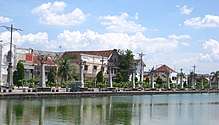
Semarang was connected to Surakarta (Solo) by a rail line in 1870.[28] At present there are two large train stations in Semarang: Semarang Poncol and Semarang Tawang. Semarang is connected to Bandung, Jakarta, and Surabaya by inter-city train services.
Air
Semarang's Ahmad Yani International Airport is served by a number of operators including AirAsia, Silk Air, Citilink, Batik Air, Garuda Indonesia, Sriwijaya Air, and Lion Air which provide services to Jakarta, Bali, Kuala Lumpur, and Singapore.[29] In 2018, the airport (under the same name) was relocated to a new and much larger site; the old airport continues to be used for government and military flights.[30]
Sea
The main seaport is the Tanjung Mas seaport.
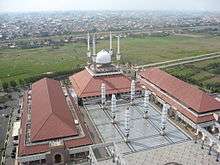
Landmarks and places of interest
- Semarang old town (Kota Lama), which is sometimes referred to by locals as "Little Netherlands." It was established in the 18th century when Indonesia was a Dutch colony. There are more than 50 well-maintained colonial buildings in Kota Lama, displaying 18th, 19th, and 20th century European-influenced architecture.[31]
- China Town: China town in Semarang has a night market known as 'Pasar Semawis', which is known for its cuisine and Chinese new year celebration.[32]
- Tugu Muda (Youth Monument) is a monument built to commemorate the services of the heroes who have fallen in the Battle of Five Days in Semarang. The height of Tugu Muda is 53 meters. Tugu Muda is located in front of Lawang Sewu at Pemuda street. It depicts the Tugu Muda fighting spirit and patriotism of Semarang residents, especially the youth who are persistent, self-sacrificing in high spirits maintaining the independence of Indonesia.[33]
- Lawang Sewu (Javanese for "A Thousand Doors") was built as the headquarters of the Dutch East Indies Railway Company. The colonial era building is reputedly a haunted house.
- Blenduk Church (Nederlandsch Indische Kerk) was built in 1753, the church is one of the oldest building in Kota Lama.

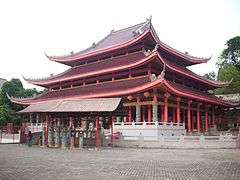
- The Sam Poo Kong temple is the oldest Chinese temple in the city.[34] Tay Kak Sie Temple was established in 1746, it is dedicated to Guanyin Bodhisattva and various Taoist Deities.
- Central Java Grand Mosque: This mosque has a Muslim museum, located at Jl. Gajah Raya. The architecture of the mosque is inspired by the mosques in Mecca and Medina.[35]
- Vihara Buddhagaya Watugong: The 45 m (148 ft) Buddhist temple has been named by MURI as the highest pagoda in Indonesia. It's located at Jl. Perintis Kemerdekaan Watugong, about 45 minutes drive from the center.
- Pancasila Square: Located within the heart of Simpang Lima City Center (SLCC) CBD; is an infamous public arena at the town center. It has tourist pedicabs, cars, bicycles, chairs, pedestrian track, public toilet, roller skates, traditional games, grass field and others.
Culture
Education
There are 593 elementary schools, 220 junior high schools, 106 senior high schools, and 88 vocational high schools, both public and private in Semarang.[36]
There are 20 universities in Semarang, 12 of them private and 8 public. The most renowned universities of Semarang are Diponegoro University and Soegijapranata University.
- Diponegoro University (UNDIP): It is one of national or state-owned universities in Semarang, founded in 1956. The university has 11 faculties: Faculty of Economics and Business, Faculty of Social and Political Sciences, Faculty of Humanities, Faculty of Law, Faculty of Medicine, Faculty of Engineering, Faculty of Fishery and Marine Sciences, Faculty of Natural Sciences and Mathematics, Faculty of Public Health, Faculty of Animal Agriculture, and Faculty of Psychology. The university also offers a postgraduate program.
- Soegijapranata Catholic University (UNIKA): It is one of the private universities in Semarang, founded in 1982. There are 8 faculties in UNIKA: Faculty of Architecture and Design, Faculty of Law and Communication, Faculty of Engineering, Faculty of Language and Arts, Faculty of Economics and Business, Faculty of Agricultural and Technology, Faculty of Psychology, and Faculty of Computer Science.
Sports
There are several sport centres in Semarang. Jatidiri sport centre or Jatidiri Stadium is one of the biggest sport centres in Semarang, located in Karangrejo, Gajahmungkur. The centre comprises a soccer field, in line skate track, tennis filed, climbing wall, swimming pool, and many others. The capacity of the centre is about 21,000 people.[37]
Knight Stadium is a futsal and basketball centre in Semarang, located in Grand Marina complex. There is a café and fitness centre in Knight Stadium.[38]
Cuisine
Semarang is widely known for its bandeng presto (pressure-cooked milkfish), Lumpia, Wingko, Tahu Gimbal, and Ganjel Rel. Semarang has also been called 'The city of Jamu' because it is an important centre for the production of jamu which are a range of Indonesian herbal medicines that are popular across Indonesia[39] Semawis Market, also known as Pecinan Semarang (Semarang's Chinatown), hosts a plethora of street food vendors, offering a wide varieties of dishes.[40]
Festivals
Dugderan is an annual festival in Semarang desecrated to welcome the Ramadan month (a fasting month for Moslems). The word "dug" describes the sound of bedug (traditional Indonesian musical instrument). The word "der" describes the sound of fireworks.
The icon of the festival is a special puppet dragon-like animal called Warak Ngendog. The word "warak" stands for "holy" and the word "ngendog" expresses a reward for Moslems. Warak Ngendog's feet are chained, representing people's desire that should be postponed during this holy month. As Dugderan is a festival unique for Semarang, it represents an important attraction for both local people and visitors.[41]
Awards
Semarang has got Adipura Award for 6 times in a row since 2012. Adipura Award is given for achievement in cleanliness and greenery at parks, streets, markets, shop buildings, premises, schools, even cleanliness of water ways and rivers.[42] Semarang City received the title of Best Smart Living and Best Smart Economy City in the Indonesia Smart Nation Award 2018.[43]
Greater Semarang
Greater Semarang was initially defined by the government as Semarang, Semarang Regency, the newly carved Salatiga city, Kendal Regency, and Demak Regency.[44] Despite the definition, it includes a lot of rural areas and the urban cores remain distinct; they have not amalgamated into a characterless metro area as in Greater Jakarta.
| Administrative division | Area (km²) | Population '000s (2000 Census) | Population '000s (2010 Census) | Population '000s (2015 Census) | Population density (/km²) |
|---|---|---|---|---|---|
| Semarang Municipality | 373.67 | 1,339 | 1,556 | 1,699 | 4,547 |
| Semarang Regency | 946.86 | 843 | 931 | 1,000 | 1,056.1 |
| Salatiga Municipality | 52.96 | 151 | 170 | 181 | 3,417.7 |
| Kendal Regency | 1,002.27 | 850 | 900 | 942 | 939 |
| Demak Regency | 897.43 | 974 | 1056 | 1117 | 1244.7 |
| Grobogan Regency | 1,975.865 | 1,268 | 1,309 | 1,351 | 683.7 |
| Greater Semarang | 5,287.96 | 5,425,000 | 5,922,000 | 6,290,000 | 1,189.7 |
Sources: BPS Jateng[45]
Notable people from Semarang
- Agung Laksono, politician and former Chairman of the House of Representatives.
- Anindya Kusuma Putri, Puteri Indonesia 2015 and Top 15 of Miss Universe 2015.
- Anne Avantie, fashion designer.
- Aries Susanti Rahayu, speed climbing world champion.
- Be Biauw Tjoan, Majoor-titulair der Chinezen, magnate, revenue farmer and bureaucrat
- Conrad Emil Lambert Helfrich, Dutch admiral.
- Daniel Sahuleka, Dutch musician.
- Fuad Hassan, politician, former Minister of Education and Culture.
- Hubertus van Mook, Dutch politician.
- Jaya Suprana, musician, writer, TV talkshow host, founder of MURI
- Liem Bwan Tjie, architect.
- Oei Hui-lan, First Lady of the Republic of China, international socialite and fashion icon.
- Oei Tiong Ham, Majoor-titulair der Chinezen, Chinese Indonesian tycoon.
- P. F. Dahler, politician, member of Investigating Committee for Preparatory Work for Independence (BPUPK).
- Purnomo Yusgiantoro, politician and current Minister of Defence.
- Raden Saleh, painter.
- Rob Nieuwenhuys, literary historian and author.
- Sutiyoso, chief of Indonesian Intelligence Bureau (BIN).
- Tukul Arwana, comedian and television personality.
- Willem Einthoven, medical doctor, invented electrocardiography (ECG), Nobel Prize winner.
- Stella Cornelia, singer and actress, ex-member of JKT48
- Max van Egmond, bass and baritone singer of Baroque and Renaissance music.
- Sri Oetari Ratna Dewi, politician
Sister cities
Semarang is twinned with:
References
- "Peringatan". sp2010.bps.go.id.
- "Semarang named cleanest tourist destination in Southeast Asia". The Jakarta Post. Retrieved 20 January 2020.
- "Jumlah Penduduk Kota Semarang" [Population of Semarang] (in Indonesian). Dinas Kependudukan dan Pencatatan Sipil Kota Semarang. October 2015. Retrieved 28 December 2016.
- "Indonesia: Java (Regencies, Cities and Districts) – Population Statistics, Charts and Map". www.citypopulation.de.
- De Gruiter, Miel. "Javindo, a contact language in pre-war Semarang". (Peter Bakker & Maarten Mous. Mixed Languages: 15 Case Studies in Language Intertwining. Amsterdam: IFOTT. 1994.) pp. 151–159.
- Purwanto, L. M. F. (2005). Kota Kolonial Lama Semarang. Dimensi Teknik Arsitektur, 33(1), 27-33
- Pratiwo. (2005). The City Planning of Semarang 1900–1970. In F. Colombijn, M. Barwegen, P. Basundoro & J. A. Khusyairi (Eds.), Old City, New City: The History of the Indonesian City Before and After Independence. Yogyakarta: Penerbit Ombak.
- Purwanto, L. M. F. (2005). Kota Kolonial Lama Semarang. Dimensi Teknik Arsitektur, 33(1), 27-33.
- Nas, P. J. M., & Pratiwo. (2002). Java and De Groote Postweg, La Grande Route, the Great Mail Road, Jalan Raya Pos’. Bijdragen tot de Taal-, Land-en Volkenkunde, 158(4), 707–725.
- Colombijn, F. (2002). Introduction; On the road. Bijdragen tot de Taal-, Land-en Volkenkunde, 158(4), 595-617.
- Cobban, J. L. (1993). Public Housing in Colonial Indonesia 1900–1940. Modern Asian Studies, 27(04), 871-896.
- Silver, C. (2008). Planning the megacity: Jakarta in the twentieth century: Psychology Press.
- Cote, J. (2004). Colonial designs: Thomas Karsten and the planning of urban Indonesia. Imprint, 2004, 01-01.
- "Tidak Langsung 34, Ada 8 Provinsi yang Baru Dibentuk pada Awal Kemerdekaan - Semua Halaman - Bobo". bobo.grid.id (in Indonesian). Retrieved 14 August 2020.
- April 30, esik; 2014 (5 May 2011). "Daftar Walikota Semarang Sejak 1945 Hingga Sekarang". Seputar Semarang (in Indonesian). Retrieved 14 August 2020.CS1 maint: numeric names: authors list (link)
- Mukhti, M. F. (19 October 2017). "Orang Semarang Melawan Jepang". Historia (in Indonesian). Retrieved 10 June 2019.
- "Ketimpangan Kota Semarang Membaik meski Ekonomi Lesu". Okezone. Retrieved 8 July 2019.
- "Semarang residents may pay property tax through Go-Pay". The Jakarta Post. Retrieved 8 July 2019.
- "Suhu di Semarang Capai 39,5 Derajat Celsius, BMKG Rilis Alasan Cuaca Panas di Pulau Jawa". TribunJateng. 14 October 2014. Retrieved 24 May 2019.
- "Weatherbase: Weather for Semarang, Indonesia". Weatherbase. 2011. Retrieved 1 December 2011.
- "Monthly weather forecast and climate = Semarang, Indonesia". Weather Atlas. Retrieved 25 July 2020.
- Isti, Bambang (16 July 2011). "Eloknya Singapore River di Banjirkanal Barat". Suara Merdeka (in Indonesian). Archived from the original on 28 December 2016. Retrieved 28 December 2016.
- Wijaya, Royce (13 August 2011). "Bendungan Utama Waduk Jatibarang Dikerjakan". Suara Merdeka. Archived from the original on 10 May 2013.
- "Semarang". Jasa Marga. Archived from the original on 4 December 2016. Retrieved 28 December 2016.
- Munir, Syahrul (6 December 2016). Alexander, Hilda B (ed.). "Tol Bawen-Salatiga Dijadwalkan Beroperasi Maret 2017". Kompas. Retrieved 28 December 2016.
- "Terminal Terboyo Rusak Parah, Terminal Mangkang Sepi". Jawa Pos (in Indonesian). 13 June 2016. Retrieved 28 December 2016.
- Purbaya, Angling Adhitya (8 December 2016). "Pengguna Angkutan Umum Meningkat, Kota Semarang Diganjar Penghargaan". detikNews (in Indonesian). Retrieved 28 December 2016.
- Cohen, Matthew Isaac (2006). The Komedie Stamboel: Popular Theater in Colonial Indonesia, 1891–1903. Ohio University Press. p. 90. ISBN 978-0-89680-246-9.
- "Flights". Semarang. Lonely Planet. Retrieved 3 December 2015.
- Media, Kompas Cyber. "Begini Penampakan Bandara Baru Ahmad Yani Semarang Menjelang Pengoperasian Halaman all". KOMPAS.com (in Indonesian). Retrieved 14 November 2019.
- "The return of Semarang's Old Town". The Jakarta Post. Retrieved 8 July 2019.
- "Thousands flock to Semarang night market to celebrate Chinese New Year". The Jakarta Post. Retrieved 8 July 2019.
- "13 must-visit places in Semarang". The Jakarta Post. Retrieved 3 December 2017.
- Suherdjoko (8 February 2016). "It's Chinese New Year for all in Semarang". The Jakarta Post. Retrieved 8 February 2016.
- "13 must-visit places in Semarang". The Jakarta Post. Retrieved 8 July 2019.
- "Data Referensi Pendidikan" (in Indonesian). Ministry of Education. Retrieved 18 March 2017.
- "GOR Jatidiri". Seputar Semarang. Retrieved 18 March 2017.
- "Knight Stadium Futsal". Seputar Semarang. Retrieved 18 March 2017.
- Kamah, Wahyuni (26 March 2012). "Semarang: Indonesia's City of Jamu". The Jakarta Globe. Archived from the original on 21 June 2013.
- "A guide to visiting Semarang". The Jakarta Post. Retrieved 8 July 2019.
- "Tradisi Dugderan di Kota Semarang". Mata Sejarah. Archived from the original on 12 April 2017. Retrieved 18 March 2017.
- Yunita, Niken Widya (3 August 2017). "Pemkot Semarang Raih Adipura 6 Kali Berturut-turut". Detik News. Retrieved 5 October 2018.
- "Pemkot Semarang Raih Predikat Best Smart Living City". Tribun News. Retrieved 8 July 2019.
- Soetomo, Sugiono (2004). "Urban Development as the interface of Regional Development from Below in central Java – Indonesia: the Case of Semarang Metropolitan" (PDF). 40th ISoCaRP Congress. International Society of City and Regional Planners. Retrieved 28 December 2016.
- "Semarang – Indonesia". Brisbane City Council. Archived from the original on 15 March 2011.
- Mardiani, Dewi (6 September 2012). "Kerja Sama Sister City Semarang-Da Nang Akan Ditingkatkan". Republika. Retrieved 28 December 2016.
- "Marzuki: Hubungan Indonesia-Vietnam Harus Ditingkatkan" (in Indonesian). Antara. 5 September 2012. Archived from the original on 6 March 2014 – via Yahoo News.
- Graaf, H. J. de (Hermanus Johannes), 1899-(?), "Chinese Muslims in Java in the 15th and 16th centuries : the Malay Annals of Semarang and Cerbon" / translated and provided with comments by H.J. de Graaf and Th.G.Th. Pigeaud; edited by M.C. Ricklefs. Publisher: [Melbourne] : Monash University, 1984. Description: xiii, 221 p. : folded map ; 21 cm. ISBN 0-86746-419-4 : Series: Monash papers on Southeast Asia ; no. 12
External links
| Wikimedia Commons has media related to Semarang. |
- Official website (in Indonesian)


